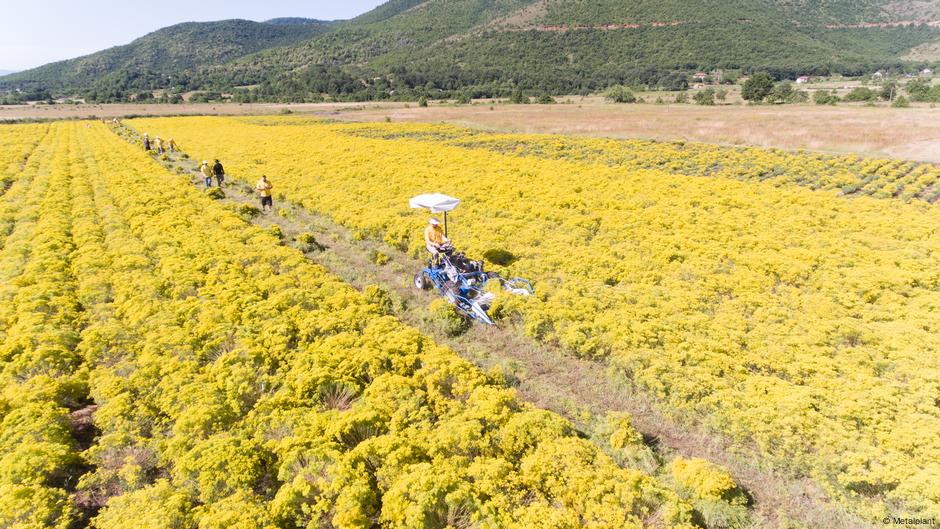
The Rise of Phytomining: Can Plants Replace Traditional Mining for Critical Metals?
The world's increasing demand for nickel, driven largely by the electric vehicle (EV) battery market, has sparked interest in innovative and sustainable extraction methods. One promising approach is phytomining, which uses plants to extract valuable raw materials from the soil. This method could potentially offer a greener alternative to conventional mining practices that can be environmentally damaging.
Hyperaccumulators: Nature's Metal Collectors
Phytomining relies on the unique ability of certain plants, known as hyperaccumulators, to absorb and store high concentrations of metals from the soil. These plants, of which there are approximately 700 known species, can accumulate nickel, zinc, copper, gold, and even rare earth elements in their shoots, leaves, or sap. This accumulation serves as a defense mechanism against predators and pathogens, rendering the plants toxic. Remarkably, the metals themselves do not harm the plants.
From Soil Remediation to Metal Extraction
The potential of hyperaccumulators was first recognized in the 1980s when scientists began using them to clean up soils contaminated by mining activities and industrial smelters. One notable application involved using plants to remove small amounts of radioactive cesium from the soil at the Chernobyl nuclear disaster site.
The concept of phytomining as a means of metal extraction emerged in the 1990s, raising the possibility of "mining" metals using plants. After 30 years of research and development, this idea is now on the verge of becoming a viable business model.
Phytomining in Practice: The Case of Albania
In northern Albania, fields unsuitable for traditional agriculture due to high nickel concentrations are now being used for phytomining. Metalplant, a startup company, operates a 10-hectare field near the town of Tropoje, cultivating Odontarrhena plants to extract nickel.
According to Eric Matzner, co-founder of Metalplant, the site is ideal for phytomining because it contains too much nickel for successful food crop cultivation but not enough to justify conventional mining operations. The company aims to extract at least one-third of a ton of nickel per hectare.
The Odontarrhena plants absorb nickel from the soil and store it in their tissues. After harvesting and drying, approximately 2% of the plants' dry weight consists of nickel. Metalplant then grinds and burns the plants, producing an ashy concentrate or "bio-ore." This ash is treated with sulfuric acid to create a liquid, which is then filtered and crystallized into nickel sulfate. This nickel sulfate is a valuable resource used in the production of large batteries, particularly those found in electric vehicles.
Environmental Advantages of Phytomining
One of the most significant advantages of phytomining is its reduced environmental impact compared to conventional mining. Antony van der Ent, a researcher at Wageningen University in the Netherlands and an advisor to Botanickel, another company in the field, emphasizes the low environmental footprint of phytomining.
Traditional metal mining often involves deforestation, the creation of toxic tailings and waste that can pollute the environment, and high greenhouse gas emissions due to energy-intensive processing. Nickel mining, in particular, can generate 10 to 59 tons of emissions per ton of metal.
Phytomining, on the other hand, is considered a climate-friendly alternative. The metal crops capture a significant amount of carbon, which is released back into the atmosphere during incineration. However, this process yields highly pure nickel with near-zero carbon emissions.
Moreover, phytomining can utilize barren land that is unsuitable for agriculture due to metal contamination. This process not only extracts valuable resources but also cleans the soil, potentially allowing for future use for forestry or recreational purposes.
The Nickel Rush and Phytomining's Potential Role
The global demand for nickel is projected to increase dramatically, potentially doubling by 2050, driven by the growing EV battery market. While much of the current nickel supply comes from Chinese-owned mines in Indonesia, phytomining could offer an alternative for countries with lower nickel concentrations in their soils, enabling them to secure their own supply.
Economic Viability and Challenges
While phytomining offers environmental benefits, its economic viability remains a key consideration. BloombergNEF, a strategic research firm, has estimated that phytomining could be too expensive for nickel buyers. However, Metalplant aims to achieve price parity with conventionally mined nickel, striving for a "green advantage" where a better product is available at the same cost. The company also combines farming with carbon capture, generating revenue through the sale of carbon credits.
In its third season, Metalplant reported harvesting over three tons of nickel on its 10-hectare field in Albania. While this is a promising start, it is significantly less than the amount extracted by conventional mines, which can produce the same quantity in approximately half an hour.
Can Phytomining Replace Conventional Mining?
To match the annual output of a single conventional nickel mine, a phytomining field would need to be 200,000 hectares in size, an area 2.5 times the size of New York City. Replacing the entire global conventional nickel production would require 15 million hectares of fields, an area equivalent to the size of Tunisia.
According to Kwasi Ampofo, a metals market analyst at BloombergNEF, economies of scale play a crucial role in the cost-effectiveness of mining operations. While larger operations tend to be cheaper, the primary challenge for phytomining is land availability.
Experts suggest that phytomining is unlikely to replace conventional mining entirely but can serve as a valuable supplementary process. Concerns have also been raised about the environmental impact of large-scale monoculture fields, which may require the use of fertilizers, pesticides, and water, similar to intensive farming practices.
Future Prospects and Community Benefits
Despite the challenges, phytomining holds promise for smaller communities struggling to grow food crops on metal-contaminated land. Researcher van der Ent believes that these communities could benefit from selling nickel while simultaneously cleaning up their soil, creating a small profit and improving their environment.

No comments:
Post a Comment